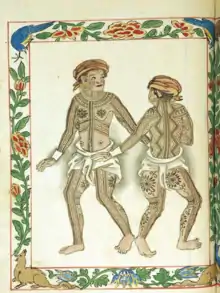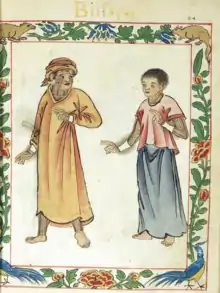Pintados
Pintados, from the Spanish word Pintado meaning painted. The term used by Spanish colonists to describe the tattooed indigenous Sebwano people and Waray people.[1][2] They were found on the islands of Cebu, Bohol, eastern part of Negros, Leyte, and Samar in the Biçayas (Visayas) region of the Philippines.[3][4] The word itself means "painted," and was first used during the Spanish colonization of the Philippines.[5]

The Boxer Codex shows both men and women were tattooed. They apply the tattoos by pricking the skin with sharp pieces of iron and then applying black powder to the open wounds which is absorbed into the skin permanently. Writing in 1565, in describing the natives, Rodriguez says: "... these Indians wear gold earrings, and the chiefs wear two clasps about the feet. All the body, legs, and arms are painted; and he who is bravest is painted most." [6]
Terminology
The inhabitants of the provinces of Camarines, located at the eastern end of the islands, and Marinduque resemble the Pintados. During 16th century, "Visayan" would only refer to the people in modern-day Western Visayas, in contrast to the "Pintados" of Central Visayas and Eastern Visayas. Today, the term "Visayan" connotes all ethnic groups of all Visayas regions, while the term "Bisaya", connotes the ethnic Sebwano people, whose ancestral land is in Central Visayas. The main ethnic group in Eastern Visayas is the Waray people.[7] Other ethnic groups that are also indigenous to central and eastern Visayas include the Porohanon people of Camotes, the Kabali-anon people of southern Leyte island, the Inabaknon people of Capul island, and the Ata people and Magahat people, both from the south of Negros island.[8][9][10]
Way of Life
Pintado native clothing
Pintado natives wear their hair long, fastened in a knot on the crown of their head. Women often wear large earrings made of gold and ivory, and decorative scarves around their heads. The women also wear skirts that reach halfway down their leg with a loose, collarless jacket with tight sleeves. Fastened in front, these garments are made of medriñaque and colored silks, wearing bahaques (breech-clouts). Tumao wore the barong mahaba.
Sagras
The Pintados have strict marriage customs, no one marries below his station. Men and women marry as many wives and husbands as they can buy and support. The women are sexually uninhibited, even encouraging their own children' sexuality.
Weapons
The Pintado's weapons consist of large curved knives, such as cutlasses, spears, and caraças (shields).
Mangubat
Tattoos are indicative of a man's bravery in battle: the more tattoos, the more success. The Pintados are a warlike race; continually waging war on both land and sea for Mangubat (booty). This word means going to other lands in search of conquest, to plunder, raid or to fight.
Lots are cast using the teeth of a crocodile or wild boar. The men inquire of their gods and ancestors, as to the result of their impending wars and journeys. Using knots made of cords, they foretell the outcome. The Indios (Indians) along the coast set out every year on plundering expeditions in the season of the bonanças, right after their harvests, which takes place between the brisas and the vendabals.
Any booty taken, of whatever nature, belongs to the chiefs, except for a small portion which is given to the Timaguas (Timawa) who go with them as oarsmen. While on raids, captured enemies are not killed. If a captive is killed, the perpetrator has to pay the chief for the victim, or, if unable to do so, serve as a slave to pay off the debt.
Larao
Larao, meaning mourning of the dead, is an observance carried out with great vigor. An enclosure is made around the house of the dead man, and if anyone, great or small, passes by and transgresses this boundary, he or she shall be punished.
When a chief dies, all mourn him with the following restrictions:
- no quarrels during the time of mourning;
- spears must be carried pointed downward, and daggers must be carried in the belt with hilt reversed;
- no brightly colored dress shall be worn during that time;
- no singing on board a barangay when returning to the village;
- strict silence is maintained.
In order that all men may know of a chief's death, one of the timawas goes through the village and announces the period of mourning. Whoever transgresses the law must pay a penalty.
Further reading
References
- John Kingsley Pangan, Church of the Far East (Makati: St. Pauls), 9.
- https://lifestyle.inquirer.net/284369/layag-samar-fest-revives-los-pintados-waray-body-tattooing-tradition/
- G. Nye Steiger, H. Otley Beyer, Conrado Benitez, A History of the Orient, Oxford: 1929, Ginn and Company, pp. 122-123.
- https://pia.gov.ph/news/articles/1009700#:~:text=The%20Pintados%2DKasadyaan%20Festival%20of,Samar%20and%20Leyte%20called%20Pintados.
- John Kingsley Pangan, Church of the Far East (Makati: St. Pauls), 9.
- Blair, Emma Helen (25 August 2004). The Philippine Islands. The Project Gutenberg EBook of The Philippine Islands, 1493-1803, Volume II, 1521-1569, by Emma Helen Blair. p. 126, Volume II.
- https://lifestyle.inquirer.net/284369/layag-samar-fest-revives-los-pintados-waray-body-tattooing-tradition/
- http://kwf.gov.ph/mapa-ng-mga-wika-rehiyon/14/
- http://kwf.gov.ph/mapa-ng-mga-wika-rehiyon/13/
- http://kwf.gov.ph/mapa-ng-mga-wika-rehiyon/5/

